The UPF Art Track opens the University’s artistic heritage to society
Is an innovative proposal by UPF to open its artistic heritage to society, via a circuit that runs through the emblematic buildings of Ciutadella campus. Six directors of leading museums in Barcelona and Madrid came to support this initiative.
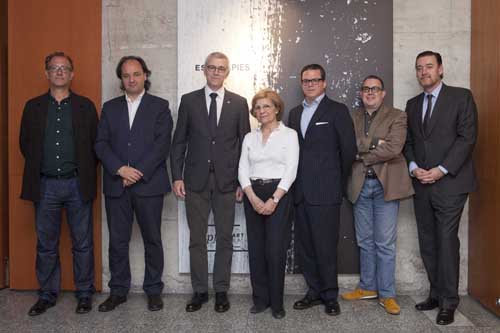
Coinciding with International Museum Day (May 18) and in the framework of the University’s 25th anniversary is the UPF Art Track is born, an innovative proposal by Pompeu Fabra University to open its artistic heritage to society, via a circuit that runs through the emblematic buildings of Ciutadella campus.
The UPF Art Track, which aims to link university, culture and art, makes three of UPF’s most precious artistic gems available to the public: Antoni Tàpies’ Reflection Room, the nerve centre of the route, and one of only two secular chapels of contemporary art in the world; the collection of contemporary works of art that different artists of international renown have donated to the University, and the Dipòsit de les Aigües (water tower), the headquarters of UPF’s Main Library.
The opening ceremony took place today, 17 May, at 12:00 pm in the Tàpies Space on Ciutadella campus, which has been turned into a museum as a result of this initiative. The event was presided over by Jaume Casals, rector of the University, and attended by Javier Aparicio Maydeu, UPF Culture delegate and promoter of the UPF Art Track, and by six directors of leading museums in Barcelona and Madrid, who came to support this initiative:
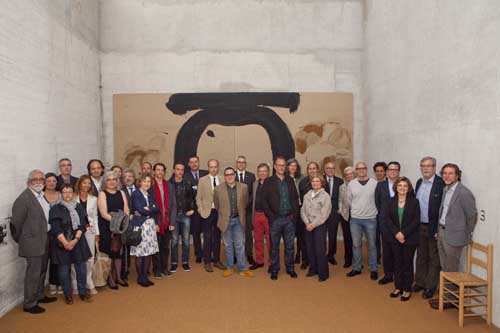
Miguel Zugaza, director of the Prado Museum; Pepe Serra, director of the National Art Museum of Catalonia; Rosa Maria Malet, director of the Joan Miró Foundation; Xavier Antich, director of the Antoni Tàpies Foundation; Bernardo Laniado-Romero, director of the Picasso Museum, and Vicenç Villatoro, Director of the Centre of Contemporary Culture of Barcelona.
Jaume Casals showed great satisfaction during the ceremony: “Today is a happy day for UPF. We wanted the University to be more able to outwardly express some of its good elements, make it more open, accessible transparent, penetrable to all citizens”. ”We are fortunate to have things that we can show off and that are easy to see and visit”, he said. And he added: “We have achieved one of the most important objectives of a modern university, not to be a citadel, or an impregnable wall”.
The rector, who commented on the fact that the UPF Art Track will be a way to facilitate interactions with secondary schools and their students, stressed the sense of public service of this initiative: “We want to be a cultural institution in itself, and we want to prove that we support public service, understood literally, for all citizens”.
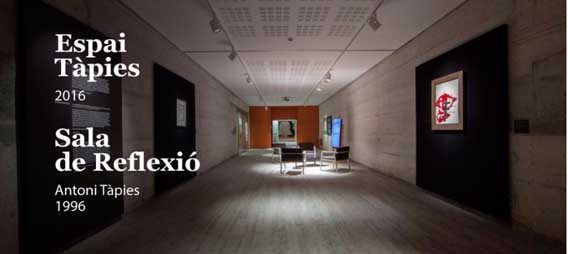
Javier Aparicio Maydeu underlined the importance of what has been achieved with the UPF Art Track incorporating culture and sensitivity to the University’s traditional mission: “Today is a great day for UPF as we celebrate the birth of our ‘protomuseum’. We are a public university, just 25 years old, and we’ve achieved a project of some substance, all centred on the campus”.
The delegate for culture highlighted some of the characteristics of different elements and content that the circuit includes, such as the Reflection Room, “a secular chapel that consists of a unique set of facilities”; the filming of nine minutes (summary of five hours of recording) by Antoni Tàpies during the construction of the Room, “a fascinating recording that allows you to see the artist in his creative process” or the Dipòsit d’Aigües (water tower), “a building that, in addition to being spectacular, is an acknowledgement of our architectural history”.
Finally, Javier Aparicio Maydeu made a call to people or institutions who want to help this project grow: “Our idea is for it to be an open box to any deposit, commission, donation or loan”, he said.
The UPF Art Track is supported by Barcelona City Council, the Department of Culture of the Catalan Government, the National Council for Culture and the Arts, the Antoni Tàpies Foundation, and the company EPSON. In addition, it will become a part of the Barcelona Contemporary Art Circuit.
A circuit that includes several artistic and architectural gems
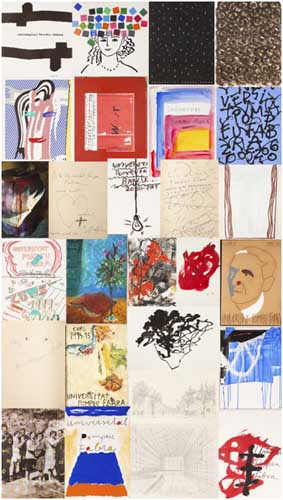
The UPF Art Track is located on the Ciutadella campus, and starts at the Roger de Llúria building, a military barracks converted in 2000 by famous architects Josep Maria Martorell, Oriol Bohigas and David Mackay.
At the heart of the campus, following the route through the vaulted ceilings that are retained from the old military building of the late 19th century, the visitor enters the Tàpies Space, the nerve centre of the UPF Art Track.
The first room, dedicated to the artist Antoni Tàpies, exhibits one of his most original works, dating from 1990, painted on canvas and on the rear, on the side of the stretcher, a procedure which leads to the flamenco tradition, and a representative painting of the work of Antonio Saura, a portrait from 1993.
The most outstanding works of the collection of paintings that UPF has created over the years, from the commemorative posters of each academic year since its foundation, can be seen on a monitor, placed on an easel so that for a moment the space takes on the air of a workshop.
The monitor shows some of the most prestigious authors of contemporary Catalan and Spanish painting: Tàpies, Ràfols-Casamada, Guinovart, Perico Pastor, Miquel Barceló, Chillida, Saura, Soledad Sevilla, Perejaume, Frederic Amat and Susana Solano, among others.
Visitors then access an intermediate space in which they can watch the video of Tàpies designing his secular chapel with the background noise of drills, radial saws and hydraulic screwdrivers, painting, placing his elements, reflecting on the space itself and its introspective function of enchantment; a symbolic nucleus at the heart of the University.
This gives way to the Reflection Room understood by Tàpies as a kind of secular chapel situated in an underground cubic crypt measuring more than 500 m3, made of concrete and presided over by his diptych of the Bell, 3 x 5 m in size (1991), and an upright column of iron lit up on a steel girder that crosses an extraordinary unique space of silence and symbolic intensity.
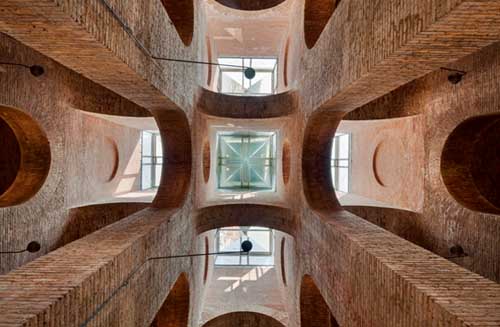
The route of the UPF Art Track concludes at the amazing Dipòsit de les Aigües (water tower) building, which was designed in 1874, at the height of Catalan modernism, by master builder Josep Fontserè, manager of the entire area of the old military citadel and for which a then young student of architecture, Antoni Gaudí, did the calculations for the tank and support elements. The interior, in the form of a hypostyle room, has 100 pillars that form a labyrinth of arches 14 metres in height.
Finally, outside visitors can enjoy two exceptional sculptures. Cantata (2013), by Susana Solano, is a tribute to philosopher and UPF professor Eugenio Trias, 20 metres of perforated stainless steel so that this beautiful apophthegm of the only Spanish Nietzsche prizewinner can be read like a frieze. “Escriure, pintar, crear o produir formes, màscares: això és viure una altra vegada i a més altura...” (To write, to paint, to create or produce forms, masks: that is to live again and at a greater height…”). And the sculpture by Alfonso Alzamora “The ladder of understanding” (2016) donated by the Vila Casas Foundation, which constitutes the special contribution by the Barcelona artist to Llull year.
